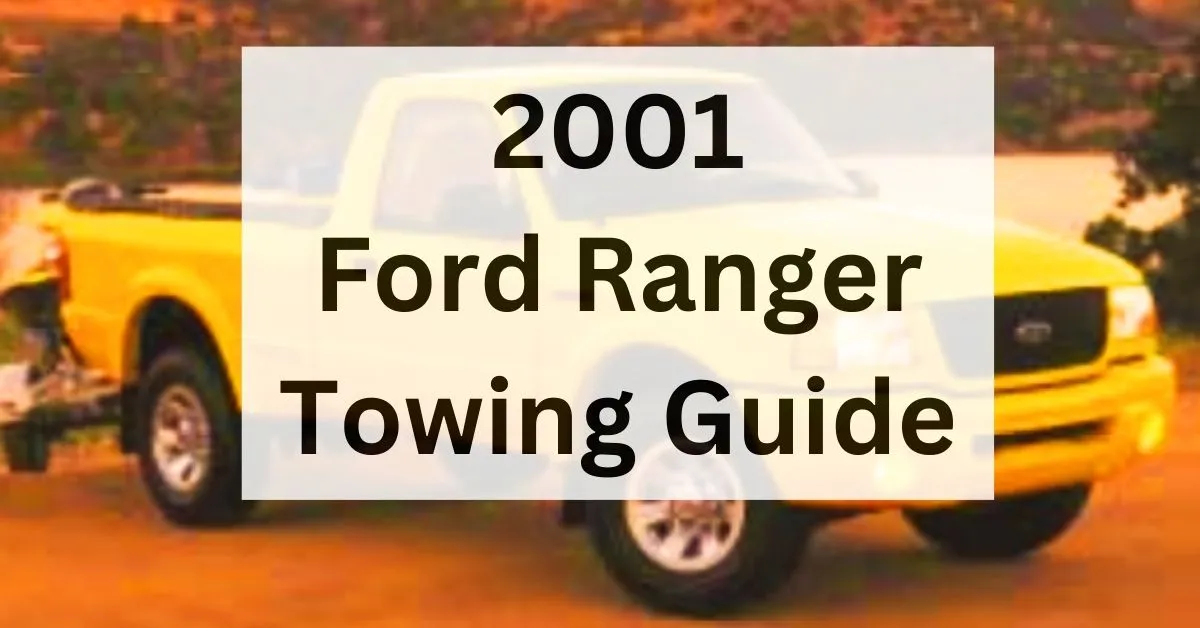The 2001 Ford Ranger is one of America’s most popular compact pickups in the truck segment. The Ranger’s mix of capability, reliability, durability, and functional value too just as tough as ever. In this article let’s take a look at the trim, cab styles, options, and the 2001 Ford Ranger towing capacity in detail.
The maximum towing capacity of the 2001 Ford Ranger is between 1,480 to 6,040 pounds when properly equipped. The maximum payload capacity is 1,640 pounds. Powered by three different 2.5L, 3.0L, and 4.0L engine options. With two body configurations Regular Cab and Supercab styles to choose from. The 4×2 or 4×4 drive comes optional with three trims XL, XLT, and Edge.
Table of Contents
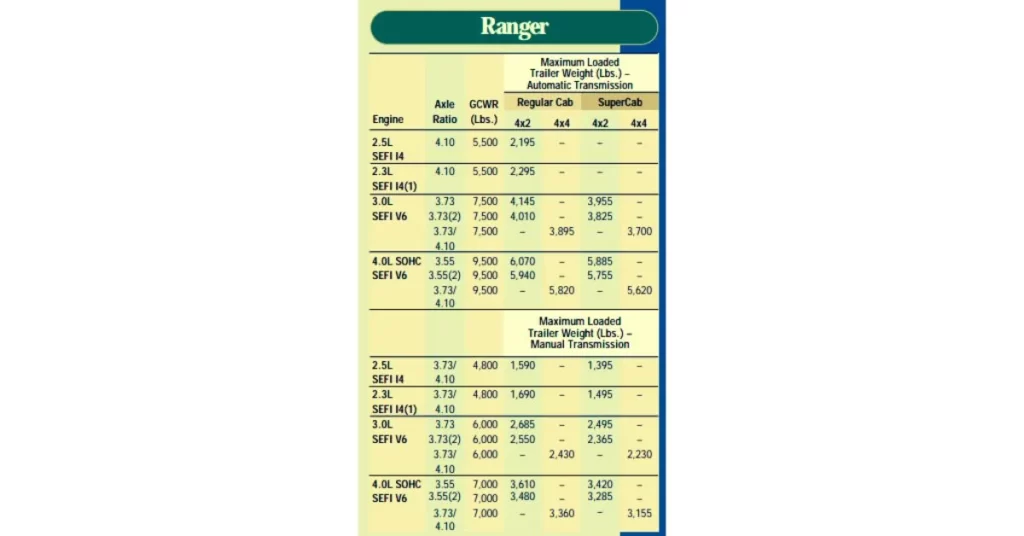
2001 Ford Ranger towing capacity chart
| 2001 Ford Ranger trim levels | 2001 Ford Ranger towing capacity |
| Ford Ranger XL | 1,480 – 6,040 lbs. |
| Ford Ranger Edge | 1,480 – 6,040 lbs. |
| Ford Ranger XLT | 1,480 – 6,040 lbs. |
2001 Ford Ranger Engine Specs
A proven engine makes Ranger an adventure machine, providing excellent torque for towing or climbing trails. Whether you choose the 4×2 or 4×4 drivetrain or explore all three trim levels, you’ll find a towing capacity that is further noteworthy of any pickup truck. The engine control calibration helps boost highway performance also an efficient package and is a rugged, reliable powerplant. The 2001 Ford Ranger has a three-engine option to choose from which are listed below.
| Engine Type | 2.5L DOHC I-4 Engine | 3.0L OHV V6 Engine | 4.0L SOHC V6 Engine |
| Maximum Power | 119 hp@ 5,000rpm | 150 hp @ 4,750rpm | 207 hp@ 5,250rpm |
| Maximum Torque | 146 lb.-ft.@ 3,000rpm | 190 lb.-ft. @ 3,650rpm | 238 lb.-ft.@ 3,000rpm |
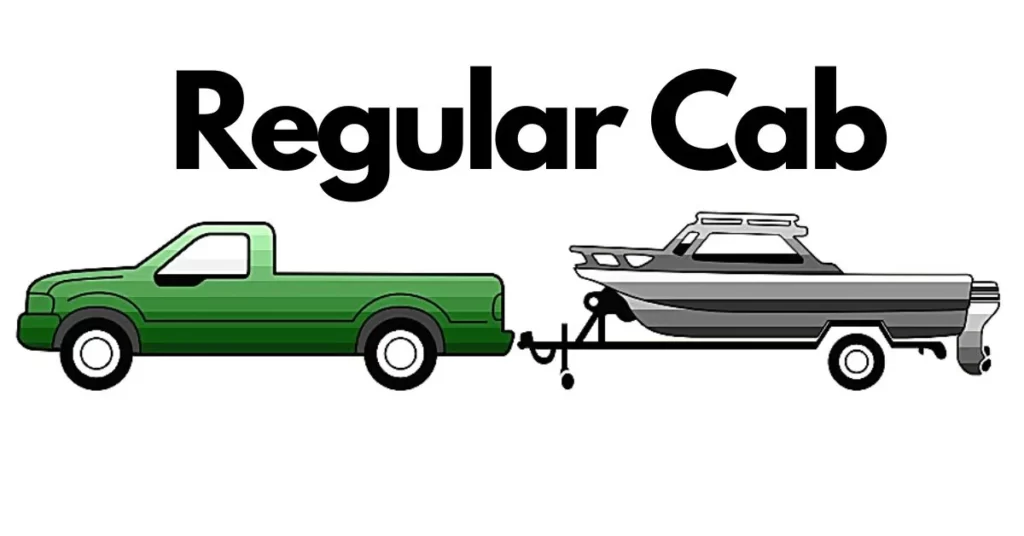
[2001 Ford Ranger Regular Cab]
Regular Cab 4×2 with Manual transmission
| Engine | Box Size | GCWR (lbs.) | Maximum trailer weight (lbs.) |
| 2.3L | 6’ box | 4,800 | 1,660 |
| 2.3L | 7’ box | 4,800 | 1,600 |
| 3.0L (non-torsion bar suspension) | 6’ box | 6,000 | 2,660 |
| 3.0L (torsion bar suspension) | 6’ box | 6,000 | 2,540 |
| 3.0L | 7’ box | 6,000 | 2,600 |
| 4.0L (non-torsion bar suspension) | 6’ box | 7,000 | 3,580 |
| 4.0L (torsion bar suspension) | 6’ box | 7,000 | 3,460 |
| 4.0L | 7’ box | 7,000 | 3,520 |
Regular Cab 4×4 with Manual transmission
| Engine | Box Size | GCWR (lbs.) | Maximum trailer weight (lbs.) |
| 3.0L | 6’ box | 6,000 | 2,380 |
| 3.0L | 7’ box | 6,000 | 2,340 |
| 4.0L | 6’ box | 7,000 | 3,320 |
| 4.0L | 7’ box | 7,000 | 3,260 |
Regular Cab 4×2 with Automatic transmission
| Engine | Box Size | GCWR (lbs.) | Maximum trailer weight (lbs.) |
| 2.3L | 6’ box | 5,500 | 2,260 |
| 2.3L | 7’ box | 5,500 | 2,220 |
| 3.0L (non-torsion bar suspension) | 6’ box | 7,500 | 2,660 |
| 3.0L (torsion bar suspension) | 6’ box | 7,500 | 4,120 |
| 3.0L | 7’ box | 7,500 | 4,060 |
| 4.0L (non-torsion bar suspension) | 6’ box | 9,500 | 6,040 |
| 4.0L (torsion bar suspension) | 6’ box | 9,500 | 5,920 |
| 4.0L | 7’ box | 9,500 | 5,980 |
Regular Cab 4×4 with Automatic transmission
| Engine | Box Size | GCWR (lbs.) | Maximum trailer weight (lbs.) |
| 3.0L | 6’ box | 7,500 | 3,860 |
| 3.0L | 7’ box | 7,500 | 3,800 |
| 4.0L | 6’ box | 9,500 | 5,780 |
| 4.0L | 7’ box | 9,500 | 5,720 |
Note : Maximum trailer weight is shown. The combined weight of the completed towing vehicle (including hitch, passengers and cargo) and the loaded trailer must not exceed the Gross Combined Weight Rating (GCWR).
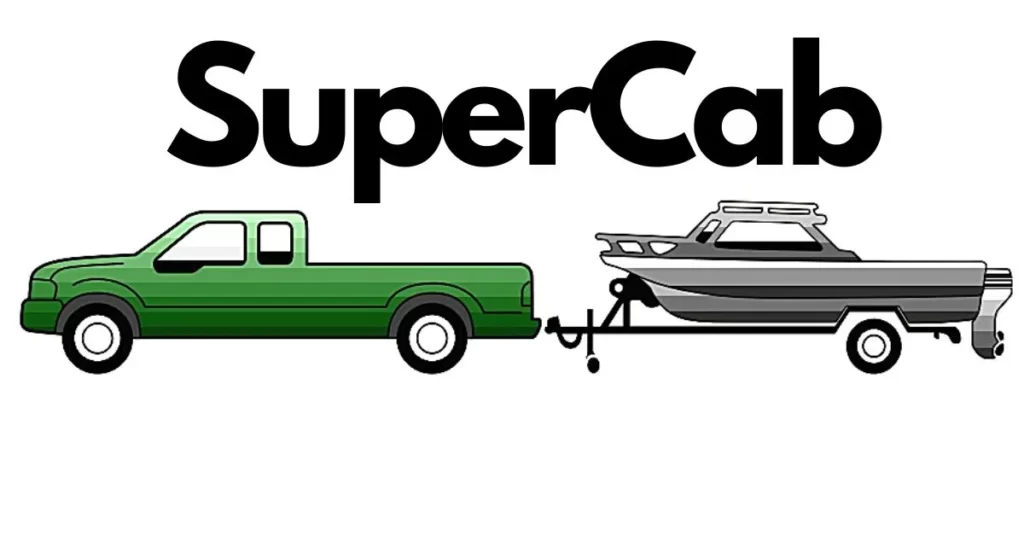
[2001 Ford Ranger SuperCab]
SuperCab 4×2 with Manual transmission
| Engine | GCWR (lbs.) | Maximum trailer weight (lbs.) |
| 2.3L | 4,800 | 1,480 |
| 3.0L (non-torsion bar suspension) | 6,000 | 2,480 |
| 3.0L (torsion bar suspension) | 6,000 | 2,320 |
| 4.0L (non-torsion bar suspension) | 7,000 | 3,400 |
| 4.0L (torsion bar suspension) | 7,000 | 3,260 |
SuperCab 4×4 with Manual transmission
| Engine | GCWR (lbs.) | Maximum trailer weight (lbs.) |
| 3.0L | 6,000 | 2,220 |
| 4.0L | 7,000 | 3,140 |
| 4.0L (FX4 package) | 7,000 | 2,720 |
SuperCab 4×2 with Automatic transmission
| Engine | GCWR (lbs.) | Maximum trailer weight (lbs.) |
| 3.0L (non-torsion bar suspension) | 7,500 | 3,940 |
| 3.0L (torsion bar suspension) | 7,500 | 3,780 |
| 4.0L(non-torsion bar suspension) | 9,500 | 5,880 |
| 4.0L (torsion bar suspension) | 9,500 | 5,720 |
SuperCab 4×4 with Automatic transmission
| Engine | GCWR (lbs.) | Maximum trailer weight (lbs.) |
| 3.0L | 7,500 | 3,680 |
| 4.0L | 9,500 | 5,600 |
| 4.0L (FX4 package) | 9,500 | 5,180 |
2001 Ford Ranger trims
A wide selection of body styles, trim levels, and options lets you build the truck that fits your work style and your lifestyle. Available in three trim levels XL, XLT, and Edge the Ranger is enhanced to provide greater fuel efficiency. Whether your idea of fun is 4X4 adventure or high-powered audio, a huge selection of body styles, trim levels, and options lets you build the truck that fits your work style and your lifestyle.
2001 Ford Ranger XL
The maximum towing capacity of the 2001 Ford XL trim is between 1,480 to 6,040 pounds when properly equipped.
The 2001 Ranger XL highlighted features are 15″ argent styled-steel wheels, Driver and front passenger airbags with manual passenger deactivation switch, 4-wheel (ABS), SecuriLock™ passive anti-theft system, Intermittent speed sensitive wipers, Quick release tailgate, Rear step bumper, 12 volt PowerPoint, Tachometer, Electronic AM/FM stereo with clock, Mud flaps, 60/40 Vinyl split bench seat, and Gas shocks.
Available models are 4X2 RegularCab and 4X2 SuperCab 2-door.
2001 Ford Ranger XLT
When equipped properly 2001 Ford Ranger XLT trim can tow up to 6,040 pounds. The 2001 Ford Ranger XLT includes all Ranger XL features, plus more than ergonomics.
The highlighted features are Chrome grille (4×2 bars/4×4 honeycomb), 15″ Painted silver styled steel wheels (4×2), 15″ Cast aluminum wheels (4×4), P225/70Rx15 All-Season BSW tires (4×2), P235/75Rx15 All-Terrain OWL tires (4×4), Courtesy lights, Door panel map pockets, Color-keyed carpeting, Cloth 60/40 split bench seat, Electronic AM/FM stereo CD player w/clock, Chrome bumpers, Platinum wheel lip moldings (4×4 style side only), and Front tow hooks (4×4 only).
Available models are 4X2 Regular cab, 4X2 SuperCab 2-door, and 4X4 SuperCab 4-door.
2001 Ford Ranger Edge
It can tow between a maximum of 1,480 to 6,040 pounds when equipped properly. The 2001 Ford Ranger Edge trim highlighted features are 16″ 5-spoke cast-aluminum wheels, Color-keyed front and rear step bumper, Fog lamps, Mud Flaps, P235/75Rx15 All-Terrain OWL tires, Electronic AM/FM stereo with single CD player, 4-speaker and digital clock, Cloth/vinyl 60/40 split bench seat, Manual styled mirrors, Honeycomb grille, Textured vinyl floor covering, Passenger grab handle, Front tow hooks, and Wheel lip moldings and bed rail covers (Styleside only).
Available models are 4X2 Regular Cab, 4X2 Regular Cab, 4X2 SuperCab 2-door, 4X2 SuperCab 4-door, 4X4 SuperCab 2-door, and 4X4 SuperCab 4-door.
2001 Ford Ranger Payload Capacity
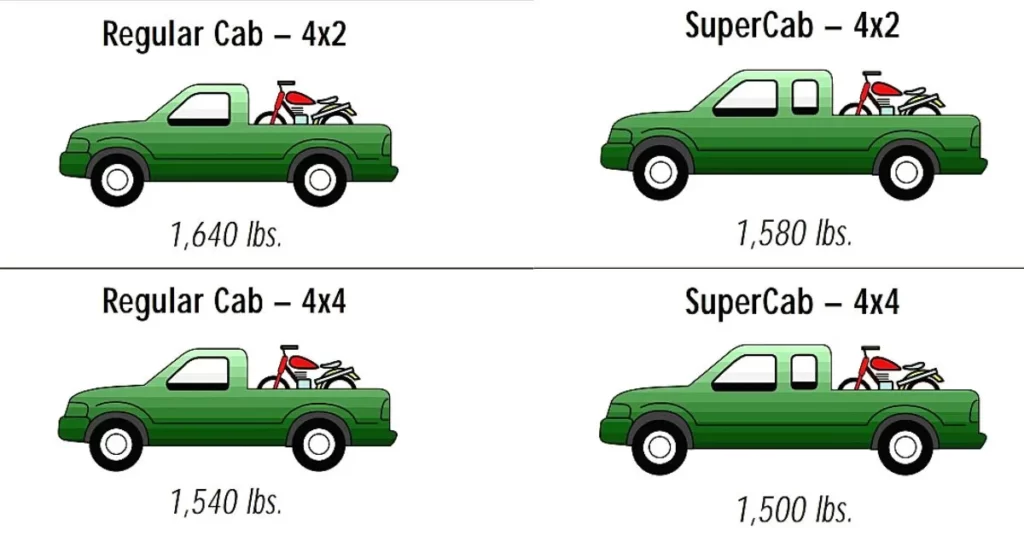
The 2001 Ford Ranger’s payload capacity is between 1,500 to 1,640 pounds when properly equipped. The maximum payload for your vehicle appears on the Tire and Loading label. The label is either on the B-pillar or the edge of the driver’s door. The payload listed on the Tire and Loading Information label is the maximum payload for your vehicle as built by the assembly plant.
If you install any additional equipment on your vehicle, you must determine the new payload. Subtract the weight of the equipment from the payload listed on the Tire and Loading label.
Note: Maximum capabilities shown are for properly equipped vehicles with the required equipment. The weight of additional options, equipment, passengers, and cargo must be deducted from this weight. The suitable loading capacity of your vehicle can be limited either by volume capacity or by payload capacity. Once you have reached the maximum payload of your vehicle, do not add more cargo, even if there is space handy.
2001 Ford Ranger Trailer Tow Package
If you plan on doing a lot of towing along you’ll need the right accessories there are a number of towing accessories that are available. The 2001 Ford Ranger Trailer Tow Package comes with:
- 4-pin trailer tow wiring harness.
- Trailer tow-Class III hitch receiver.
- Tow hooks
Note: Always use the proper equipment for towing a trailer and make sure it is properly attached to your vehicle. Contact your authorized dealer or a reliable trailer dealer as soon as possible if you require assistance.
- Hitches
For towing trailers up to 2,000 lbs, use a weight-carrying hitch and ball which uniformly distributes the trailer tongue loads through the underbody structure. Do not install a single or multi-clamp type bumper hitch, or a hitch that attaches to the axle. Underbody-mounted hitches are acceptable if they are installed properly. Whenever a trailer hitch and hardware are removed, make sure all mounting holes in the underbody are properly sealed to prevent harmful gases or water from entering. - Safety chains
Always connect the trailer’s safety chains to the frame or hook retainers of the vehicle hitch. To connect the trailer’s safety chains, cross the chains under the trailer tongue and allow slack for turning corners. Also, remember not to attach safety chains to the bumper. - Trailer brakes
Electric brakes and manual, automatic, or surge-type trailer brakes are safe if installed properly. The trailer brakes must meet local and Federal regulations. Do not connect a trailer’s hydraulic brake system directly to your vehicle’s brake system. Your vehicle may not have enough braking power and your chances of having a collision greatly increase. The braking system of the tow vehicle is rated for operation at the GVWR, not GCWR. - Trailer lamps
Trailer lamps are required on most towed vehicles. Make sure all running lights, brake lights, turn signals, and hazard lights are working. Contact your authorized dealer or trailer rental agency for proper instructions and equipment for hooking up trailer lamps. - Trailer tow connector
The trailer tow connector is located under the rear bumper, on the driver’s side of the vehicle.
Also Read: 2004 Ford Ranger towing capacity 2003 Ford Ranger towing capacity 2002 Ford Ranger towing capacity
2001 Ford Ranger Trailer Towing Guidelines
- Practice turning, stopping, and backing up before starting on a trip to get the feel of the vehicle-trailer combination. When turning, make wider turns so the trailer wheels will clear curbs and other obstacles.
- Towing trailers beyond the maximum recommended GVWR or the GAWR specified could result in engine damage, transmission damage, structural damage, loss of vehicle control, and vehicle rollover.
- Do not exceed the lowest rating capacity for your vehicle or trailer hitch. Overloading your vehicle or trailer hitch can impair your vehicle’s stability, loss of control, and handling.
- Make sure that the vertical load on the tow ball is between the minimum and maximum recommended weight at all times.
- Do not tow a trailer fitted with electric trailer brakes unless your vehicle is fitted with a compatible aftermarket electronic trailer brake controller.
- Place loads as low as possible and central to the axle of your trailer for the best stability of the trailer in an unloaded vehicle.
- After you have traveled 50 miles, thoroughly check your hitch, electrical connections, and trailer wheel lug nuts.
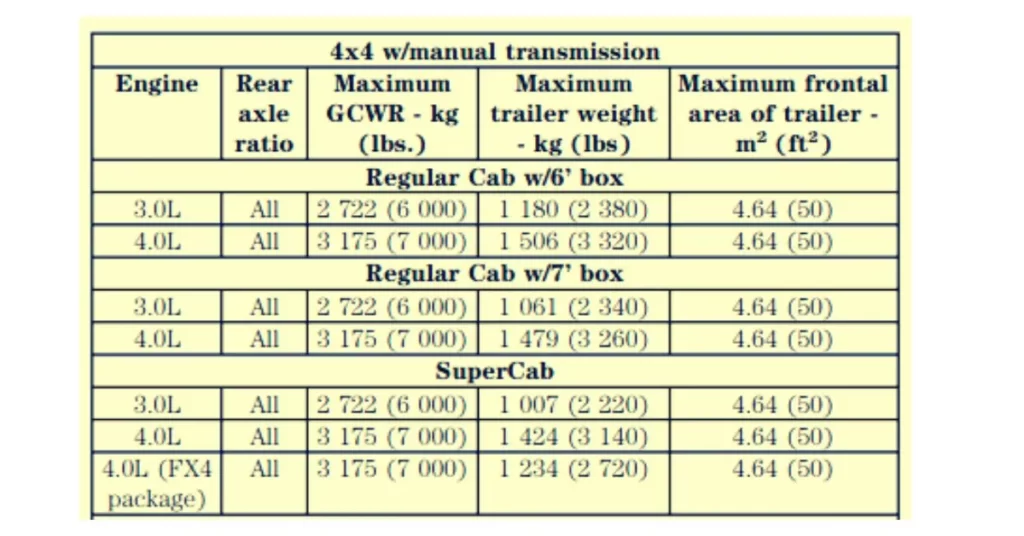
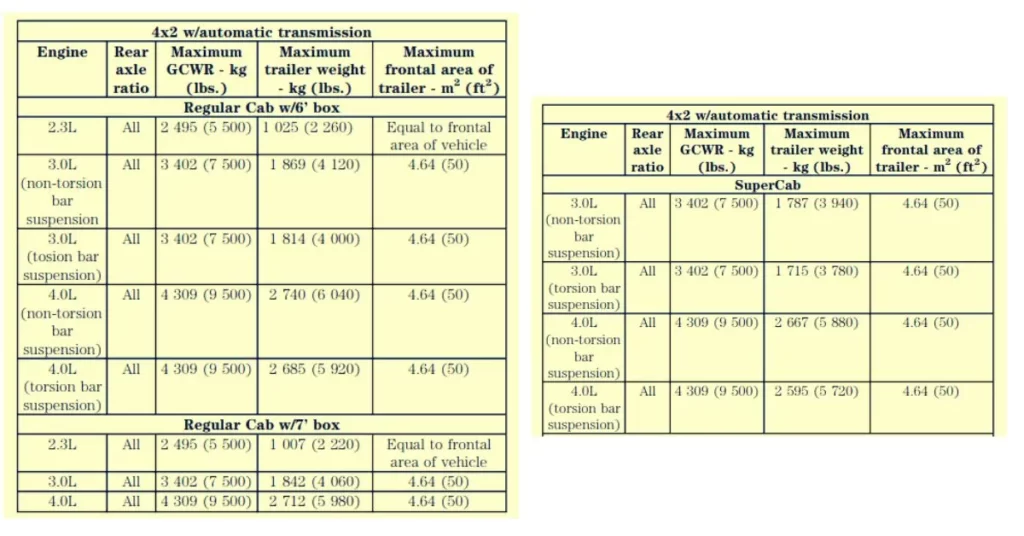
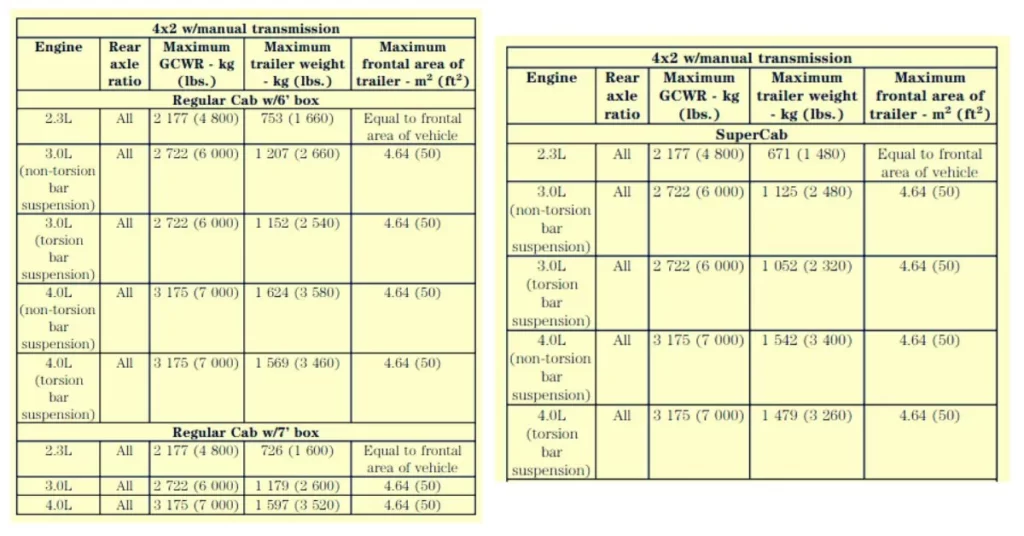
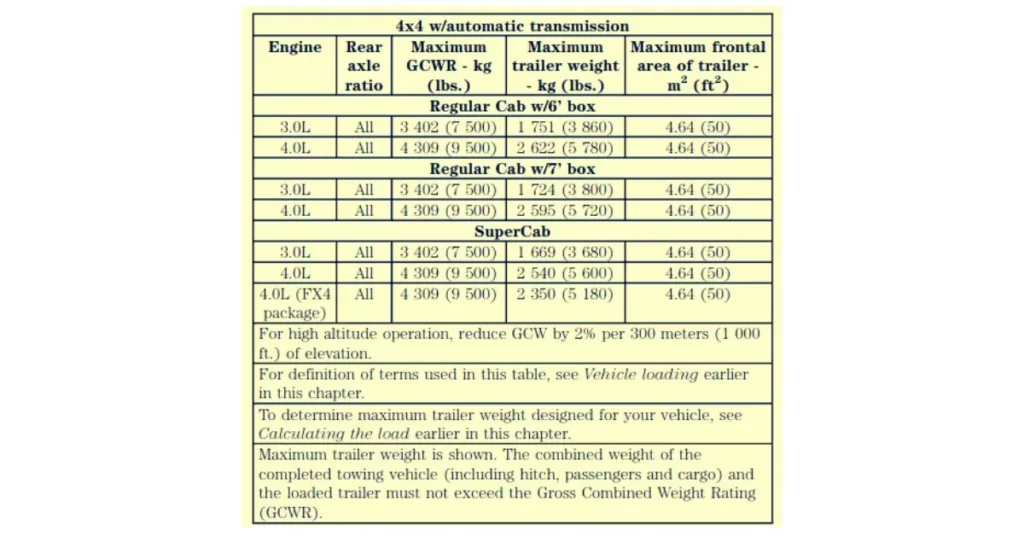
Aaron Bennett is an accomplished author and a true aficionado when it comes to pickup trucks. With an unwavering passion for all things automotive, Aaron has dedicated his life to exploring the world of pickups and sharing his expertise with others. As the proud owner of several powerful machines, he has spent countless hours behind the wheel, navigating rugged terrains and conquering highways with unrivaled enthusiasm.

